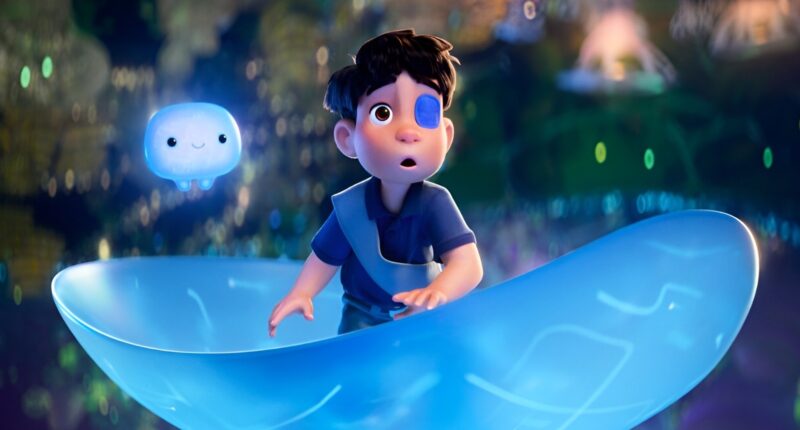Share this @internewscast.com
Back in 2018 and 2019, Walt Disney Pictures achieved a remarkable feat, raking in over $3 billion in domestic grosses each year. The year 2019 alone amassed $3.74 billion, showcasing Disney’s brands—Marvel Studios, Lucasfilm, Pixar, and Disney Animation—at their zenith. Fast forward six years, and the landscape looks quite different for Disney. Although the live-action “Lilo & Stitch” remake holds the title for the largest American release this year, the studio’s current domestic earnings hover around $1.6 billion.
Upcoming sequels like “Zootopia 2” and “Avatar: Fire and Ash” are expected to push Disney past the $2 billion mark domestically by year’s end. However, the company cannot overlook a series of significant flops this year, including “Snow White,” “Elio,” and “Tron: Ares.” Even the Marvel Cinematic Universe’s well-received entries like “Thunderbolts*” have struggled to make an impact. This raises the question: What challenges are keeping Disney’s releases stuck in a box office rut throughout 2025?
Several factors contribute to Disney’s struggles at the 2025 box office, such as the limited audience appeal of their major projects and ballooning production costs. Delving into these issues reveals why Disney has faced such a steep financial decline since the late 2010s, a downturn that neither The Grid nor The New Avengers could overcome.
A surprising revelation from the opening weekend of “Tron: Ares” was that only 30% of its $33 million debut came from viewers under 25. Instead, the majority of its audience fell between the ages of 25 and 54. This unexpected demographic shift underscores how the studio’s 2025 offerings have skewed older, which has hampered its box office performance.
Once a magnet for families and teenagers, Disney’s 2025 lineup has primarily attracted an older crowd. For instance, February’s “Captain America: Brave New World” saw just 12% of its opening weekend audience under 18, while 45% were aged 35 and older. “The Fantastic Four: First Steps” fared slightly better, but still, 31% of its initial audience was over 35. New releases like “Freakier Friday” aim to tap into nostalgia for those 30 and up, limiting the appeal to younger viewers and capping potential box office success.
Too many movies aimed at older audiences
Disney’s all-ages blockbusters were once its hallmark. By focusing primarily on older demographics, the studio struggles to replicate the broad appeal of hits like “The Avengers.” Tough realities, such as Pixar’s diminished draw for young audiences, weigh down Disney’s box office prospects.
While classic Mouse House blockbusters were catnip for families and teenagers, 2025 Disney has largely drawn in older audiences. February 2025’s “Captain America: Brave New World,” for instance, only scored 12% of its opening weekend from audiences under 18. Moviegoers 35 years and older accounted for 45% of “Brave New World’s” bow. “The Fantastic Four: First Steps” skewed a little younger, but 31% of its opening weekend audience were made up of folks in the 35+ age bracket. Now, projects like “Freakier Friday” seek to score nostalgia from audiences 30 and up rather than youngsters, ensuring that many of Disney’s 2025 movies came with an inherent ceiling.
All-ages blockbusters used to be Disney’s bread-and-butter. By only appealing to older audiences, it’s hard to reach the heights of titles like “The Avengers” that resonated with everyone. Harsh realities, like the Pixar brand name not being essential for young audiences, are suppressing Disney’s box office potential.
Diluting theatrical films with streaming releases
In the early 2020s, a trio of Pixar films, rather than embracing their original theatrical release plans, were sent straight to Disney+ as a way to bolster subscription numbers. “Soul,” “Luca,” and “Turning Red” generated strong viewership figures on Disney+, but also ensured audiences would associate Pixar features (particularly non-sequels) with at-home viewing. In the past, original works like “WALL-E” and “Brave” could stand toe-to-toe with big summer blockbuster sequels. In 2025, though, “Elio” absolutely cratered with a $154 million worldwide gross. One of the year’s biggest flops, “Elio” reflected how far the Pixar brand had fallen in theaters.
Whether originals or sequels, Pixar was previously an essential ingredient to Disney’s dominance. In previous years like 2004, a Pixar feature like “The Incredibles” could account for as much as 25% of Disney’s annual box office gross. In 2010, “Toy Story 3’s” immense $415 million domestic take made up roughly 30% of Disney’s North American box office business. Pixar’s lost luster alone illustrates why Disney is having a hard time in 2025.
Back then, “Toy Story 3” or “Inside Out” could cover up the losses of “Prince of Persia: The Sands of Time” and “Tomorrowland.” Now, new Pixar endeavors like “Elio” are weighing down Disney’s box office reputation. Much like with Marvel Studios and Lucasfilm, short-term streaming gains proved fatal for the long-term success of Pixar and Disney.
Shrinking international box office numbers
In the 2010s, the Marvel Cinematic Universe, particularly its Phase Three installments, could crack $500+ million internationally without breaking a sweat. Certain titles like “Captain Marvel” and “Captain America: Civil War” could even exceed $700 million in overseas territories. “Avengers: Endgame” grossing a staggering $1.9 billion internationally was the ultimate testament to the MCU’s global prominence.
Fast forward to 2025, and the MCU’s more limited worldwide appeal has become glaringly apparent. “Captain America: Brave New World” only grossed $213 million overseas while “Thunderbolts*” topped out with a dismal $192.2 million. Even 2025’s biggest MCU movie, “The Fantastic Four: First Steps,” only grossed $246.36 million internationally, beneath “Ant-Man’s” nearly $340 cume a decade earlier. These costly superhero films have gone from being royalty to paupers in the grander box office landscape. Similar struggles have plagued other 2025 Disney movies, with “Snow White” only grossing $118.47 million and “Elio” fizzling out at $81.14 million in non-American numbers, a shadow of what such tentpoles used to take in during the 2010s.
With foreign territories showing indifference to Disney’s biggest franchises (Korean audiences aren’t captivated by “Star Wars”), the worldwide box office hauls of the studio’s blockbusters have drastically decreased. It’s clear that once-essential overseas markets are now meeting the studio’s output with increased indifference.
Those excessive budgets
Shortly after “Elio’s” debut, allegations emerged that the film’s costs had skyrocketed well beyond $200 million in the midst of the feature’s countless production problems. Costing considerably more than $200 million would’ve made “Elio” the most expensive Pixar movie in history, far surpassing the costs of anticipated sequels like “Inside Out 2” and “Incredibles 2.” The tormented Pixar flop wasn’t the only 2025 Disney title to have a bonkers price tag, though.
Marc Webb’s “Snow White” also had a bizarrely hefty $270 million budget. That would’ve made “Snow White” considerably costlier than past Disney Animation remakes like 2019’s “The Lion King.” Then there was “Tron: Ares,” which chalked up $180 million in expenses for Disney. Compare that to 2025 phenomenon “Sinners,” which cost only $90 million to make. Disney’s cinematic exploits this year have been marked by extravagant budgets that ensured profitability remained a pipe dream.
Accusations of behind-the-scenes turmoil informing these heightened budgets only rubbed salt in their wounds. Failing to nail these films down creatively led to inflated budgets that were nearly impossible to recoup. Safe to say, a little more financial restraint and trust in their creative team would’ve gone a long way in diluting such struggles.
Running old brand names into the ground
In the 2010s, cranking out new “Star Wars” or “Marvel Cinematic Universe” projects annually while bringing back semi-recent hits like “Finding Nemo” and “The Incredibles” was a recipe for financial success. In the 2020s, though, the Mouse House has struggled with seemingly “surefire” franchise fare. Resurrecting the “Indiana Jones” and “West Side Story” brand names, for instance, didn’t produce box office hits, a problem that has only grown increasingly pervasive.
“Snow White,” for instance, flopped nearly 90 years after the original animated “Snow White and the Seven Dwarfs” hit theaters. While modern kids, millennials, and Gen-Z audiences remain enamored with “Beauty and the Beast” and “Aladdin,” that initial 1937 feature is a whole other story. Trying to wring a modern box office hit out of such an arcane project proved a fool’s errand. Then there was the October 2025 misfire “Tron: Ares,” a sequel rooted in a 40+ year old sci-fi franchise that was never particularly popular to begin with, cementing its box office downfall.
Focusing so hard on brand names that have existed for ages, rather than coming up with new, relevant stories for a fresh crop of moviegoers, just isn’t working out for Disney. In its obsession with the past, Disney has failed to produce modern box office smashes.









